Wigan Tramways Company
(later Wigan and District Tramways Company)
History
Wigan Tramways Company commenced horse-drawn operations on the first section of its newly built 3ft 6ins-gauge tramway on the 31st July 1880. Although the company was very keen to introduce steam haulage, these were early days for this particular technology (in terms of street operation), so the company initially had to make do with horse traction, even though the line out to Pemberton was very steeply graded, and thus unsuited to the use of horses.
The company eventually received approval to introduce steam traction on a temporary basis — the first steam service running on the 8th February 1882 — making it one of the earliest adopters of this method of traction in England, though this was not to be without negative consequences given the unreliability of early engines, the weakness of the track, and the general hostility of the local authorities (Wigan Corporation and Pemberton Local Board). All these factors, combined with the lack of a connection between the company's two routes (east and west of Wigan), a fatal accident and a scandal involving the company secretary — who disappeared with a significant sum of the company's money — led to severe financial difficulties. Matters were compounded in early 1885 by an extremely short-sighted decision — forced upon the directors by the shareholders, and against their advice — to sell the horses and thus end horse tram operation, which duly took place in late March or early April 1885. Whilst horses were expensive to keep, the company simply had too few steam engines to deliver a proper service, which inevitably resulted in a dramatic drop off in passenger numbers.
Despite stringent management of costs, the service became ever-more unreliable as the few engines the company had became increasingly worn out and prone to failure. By 1887, the continuing lack of dividends led to a shareholder revolt, with many of the existing directors being forced out. This resulted in a complete revamp of the management, as well as the purchase of new engines. Although passenger numbers increased and the company was at last able to pay moderate dividends, further troubles were just around the corner. The company already needed to renew worn out track and repay debenture holders — which it was struggling to do — and on top of this, in 1889, a fatal accident occurred. All these combined to undermine confidence in the company, and a petition was filed to wind it up, forcing the company into receivership in the summer of 1890.
The tramway struggled on under the Receiver, who subsequently auctioned it off, a local businessman — Councillor John Gee — taking control on the 16th October 1891. Under Gee's ownership, the company's fortunes were gradually improved, and in February/March 1892, a new company — the Wigan and District Tramways Company — was formed to run the services under a lease arrangement with Wigan Corporation, the latter agreeing to take possession of the tracks (around June that year; the exact date is unclear), which they then maintained. New lines were built by the corporation, which were then leased to the company, the latter operating the system very successfully for just over a decade.
The corporation obtained powers to construct more lines on the 25th July 1898, as well as to electrify the system and work it itself. Although the company expressed an interest in operating the new system (or the portions of it that they thought would be profitable), the corporation had decided on municipal operation. The corporation ran its first electric service on the 25th January 1901, before purchasing the W&DTCo on the 30th September 1902.
At its greatest extent the steam tramway extended to 5.49 miles. Throughout its life, the system consisted of two unconnected halves: a line westwards from Queen St, through Pemberton to Lamberhead Green, and another eastwards from King Street through Ince to Hindley. A third line, built by the corporation, ran southeastwards from Darlington St on the Hindley line to the King William Hotel in Platt Bridge, from where a short company-owned extension ran to Lily Lane. The steam tramway was not connected to any neighbouring systems, so was always operated in isolation.
Uniforms
Photographs of the early horse-drawn era of the Wigan Tramways Company do not appear to have survived; however, given that uniforms were certainly not worn by their colleagues on the steam tram services, it seems highly likely that horse tram drivers and conductors simply wore informal attire.
Several good quality images have survived that show steam tram crews in both WTCo days (up until March 1892) and W&DTCo days (up until municipalisation in September 1902). These photos clearly show that drivers wore very similar attire to their railway counterparts, namely, heavy cotton trousers and jackets, frequently of a light colour, possibly grey or beige. Headgear also followed railway practice, with photos invariably revealing soft-topped or grease-topped caps. No badges were worn, either on the jackets or the caps.
In common with the majority of horse and steam tramways, conductors simply wore smart but informal attire — trousers, shirts and jackets — along with the normal headgear of the day, either the bowler hat, or the flat cap. Once again, no badges or insignia of any kind, including licences, were worn.
A couple of photographs of inspectors have survived (see below), and these provide enough detail to permit an accurate description of the uniforms they wore. The earliest uniform (in WTCo days) was single-breasted, and was worn with a soft-topped cap; it is unclear whether the uniform or cap carried insignia of any kind. A photo of 1893 however (i.e., in the early days of the W&DTCo), shows an inspector in an elaborate single-breasted jacket with hidden buttons (or more than likely a hook and eye affair), edged in a finer material than the main body; this was also used to give a 'bandsmans frog' effect on the front of the jacket. The cap was now more of a pillbox-style of kepi with a shiny peak; it certainly carried the bearer's grade — Inspector — in script lettering, though whether this was embroidered or metal is unclear.
Further reading
For a detailed history of Wigan's steam tramway system, see 'The Tramways of Wigan' by E K Stretch; Manchester Transport Museum Society (1978).
Images
Steam tram drivers and conductors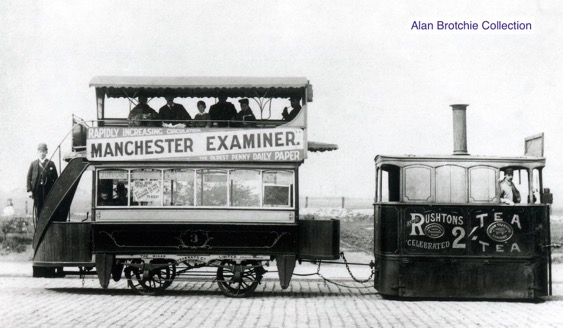
A lovely photograph of what would appear to be a relatively new Steam Tram No 3 (a Wilkinson locomotive) and Trailer No 3 (an Ashburys-built Eades reversible product) — photo undated, but probably taken in the mid 1880s (the trailer is marked 'Wigan Tramways Company').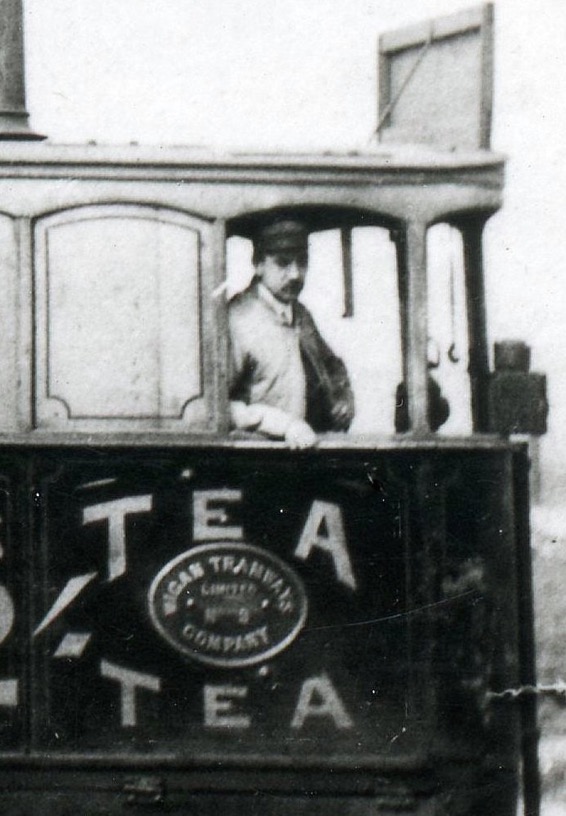
A blow-up of the above photo showing the driver, who would appear to be wearing a light-coloured cotton jacket and a soft-topped cap, all without markings or badges.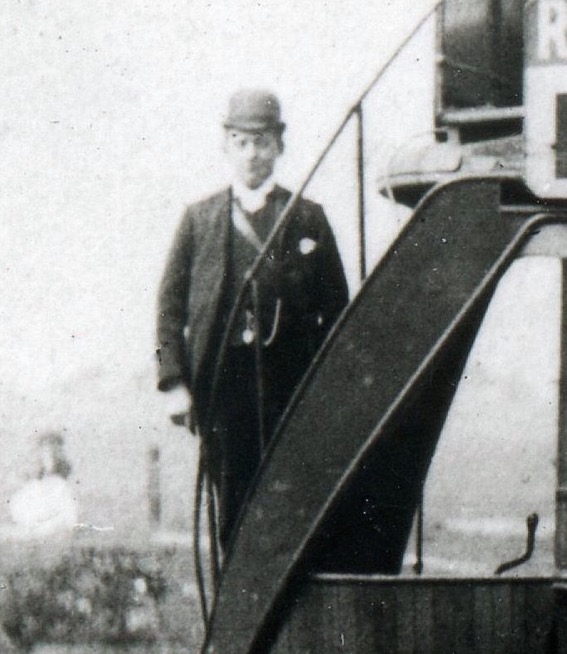
Another blow-up of the above photo, this time showing the conductor. He is wearing an informal jacket and a bowler hat. The light-coloured area on his left breast is probably a handkerchief rather than a licence.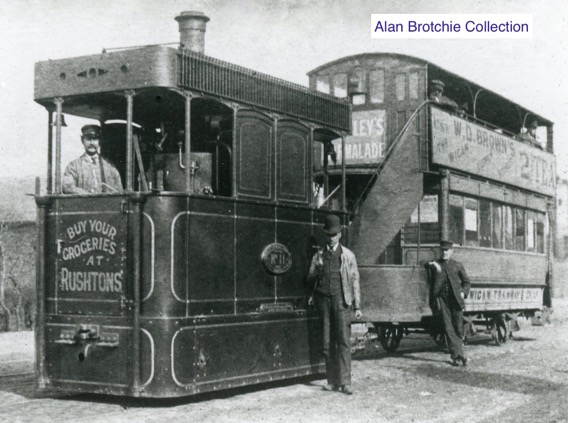
A driver, stoker (or fitter), and probably an inspector, pose for the camera with Engine No 11 (an 1886-built Wilkinson locomotive) — photo undated, but probably taken in the late 1880s (the engine is in good condition, and the rather battered trailer is clearly marked 'Wigan Tramways Company').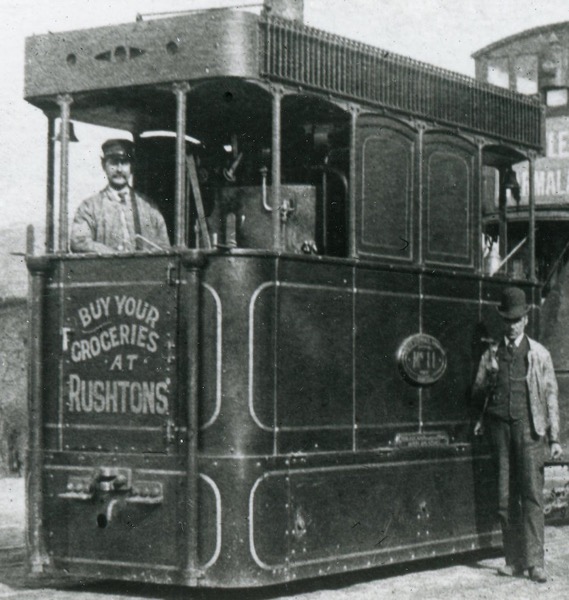
A blow-up of the above photo showing the driver and the stoker (or fitter), both wearing light-coloured cotton jackets, the former in a soft-topped cap and the latter in a bowler hat. 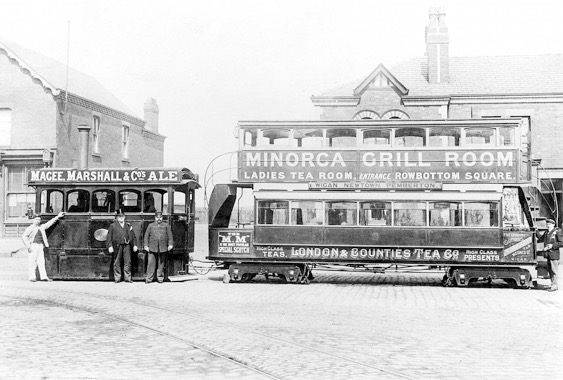
Engine No 12 (a Kitson of 1893) looking very shiny, along with a pristine-looking trailer in Ormskirk Rd, Pemberton. Although the photo is undated, the fact that both the engine and trailer are almost new, strongly suggests that it was taken in 1893. The man in the top hat is probably John Gee, a local businessman who had been instrumental in reviving the fortunes of the tramway. Photo courtesy of David Gladwin, with thanks to Trevor Preece.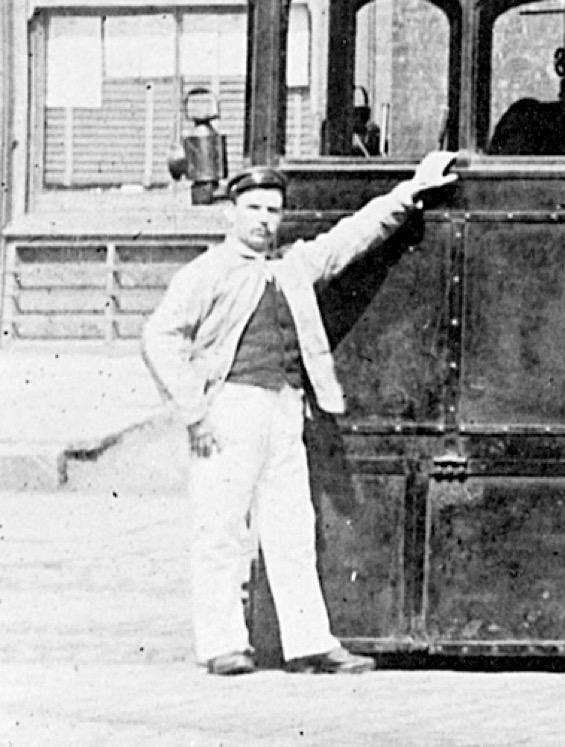
A blow-up of the above photo showing the driver, in light-coloured jacket and trousers, along with a soft-topped or grease-topped cap. The light-coloured area on the latter is very probably a reflection rather than a badge.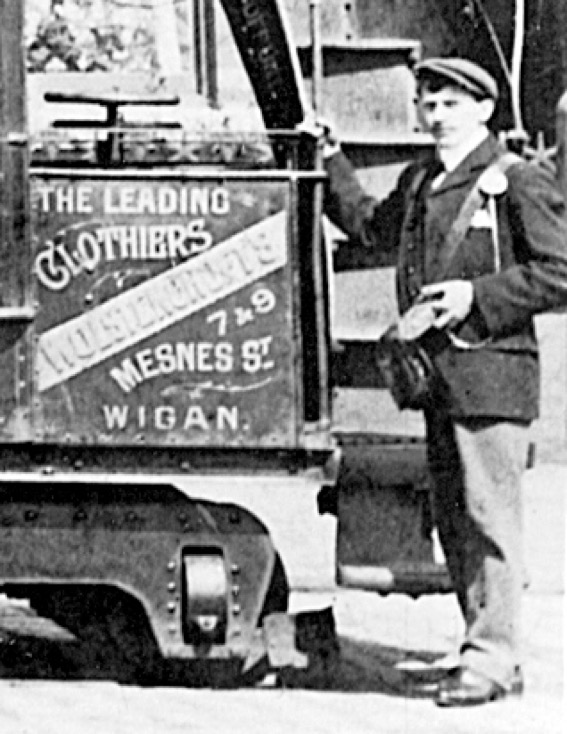
Another blow-up of the 1893 photo above, this time showing the conductor, in informal jacket and flat cap. Although he would appear to be wearing a licence on his cash-bag strap, this is possibly an attachment for a ticket punch given the long string/chain connecting it to something in his hand.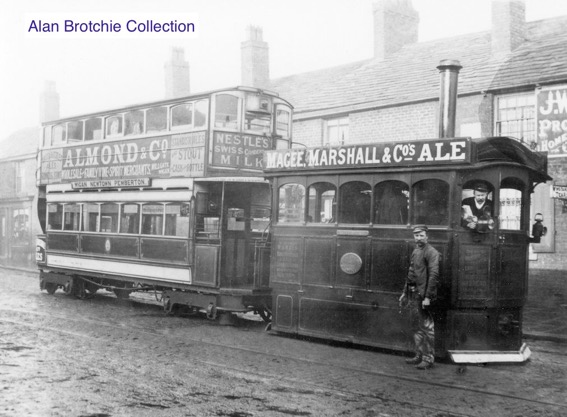
Kitson steam tram and trailer captured in Ormskirk Rd, at the Pemberton terminus — photo undated, but probably taken in the mid-to-late 1890s.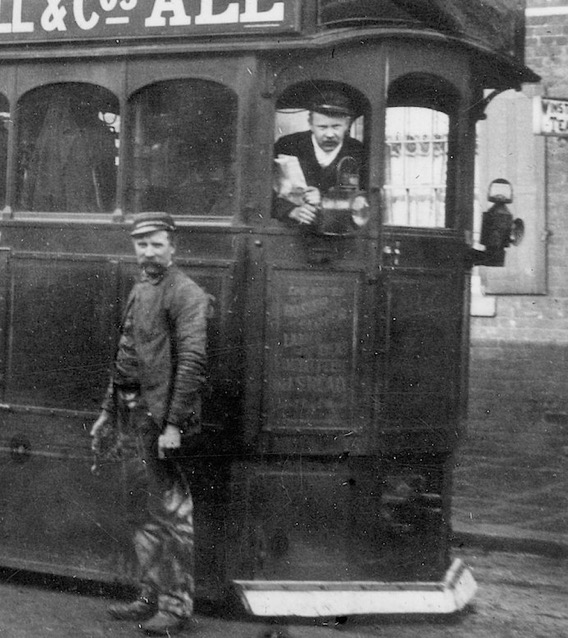
A blow-up of the above photo showing the stoker (or fitter) and driver, both of them staring intently at the cameraman. Their soft-topped caps do not carry badges of any kind.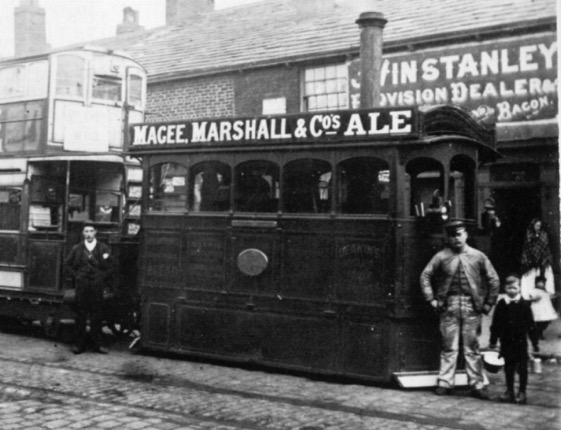
A conductor and driver with a later Engine No 11 (also a Kitson locomotive) at the Pemberton terminus — photo undated, but probably taken in the mid-to-late 1890s. Photo courtesy of the Tramways and Light Railway Society, with thanks to David Voice.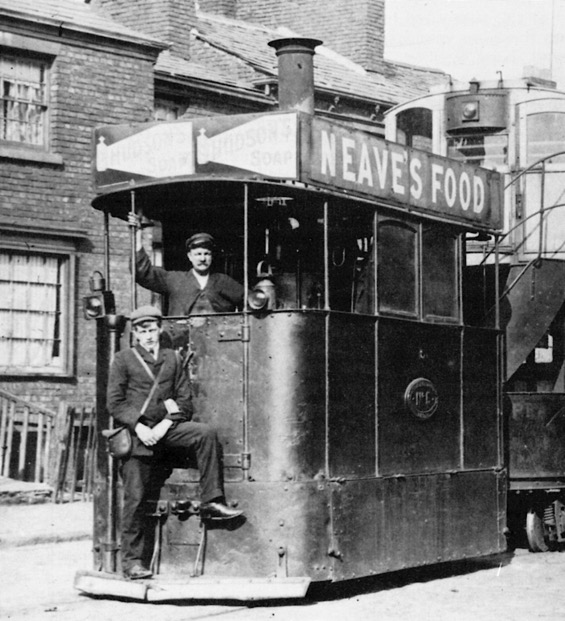
A conductor and driver pose with Engine No 5 (an ex-Brighton District Tramways, Wilkinson-built steam tram) somewhere on the Hindley route — photo undated, but probably taken around the turn of the century. Both men are wearing typical 'steam tram' attire, the driver in railway footplate-like clothing and the conductor in robust but informal attire, inclusive of a flat cap. Photo courtesy of the Tramways and Light Railway Society, with thanks to David Voice.
Senior staff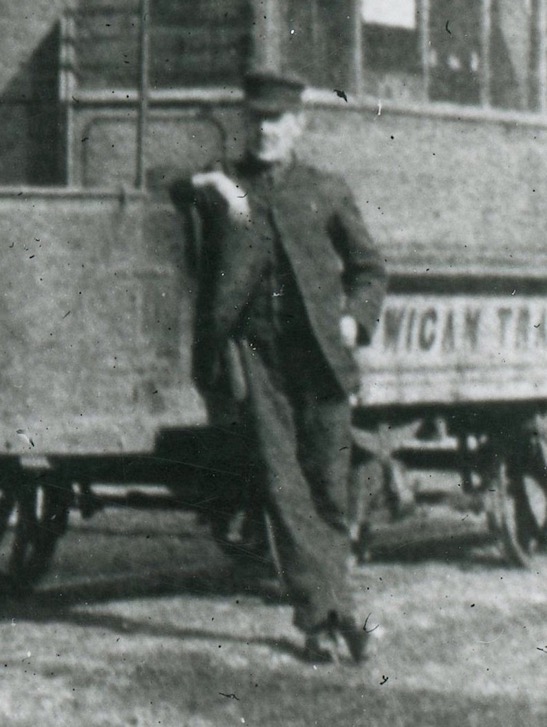
A blow-up of the late 1880s photo of Engine No 11 above, showing an individual who is more than likely an inspector. His uniform and cap do not appear to bear any insignia.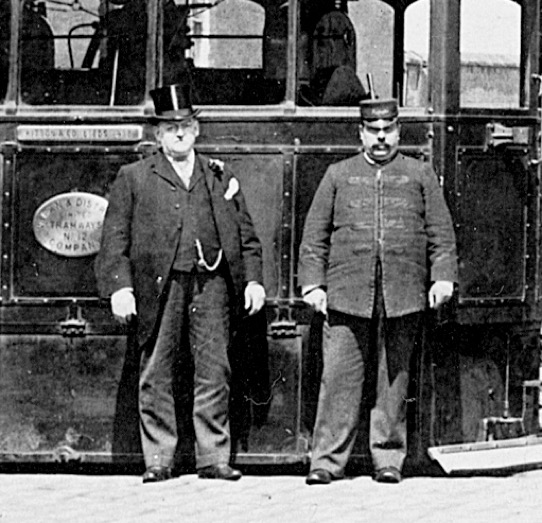
A blow-up of the 1893 photo above showing the rather portly inspector, in single-breasted jacket with bandsman's frogs and a kepi-style cap; the latter appears to bear his grade Inspector in script-lettering.